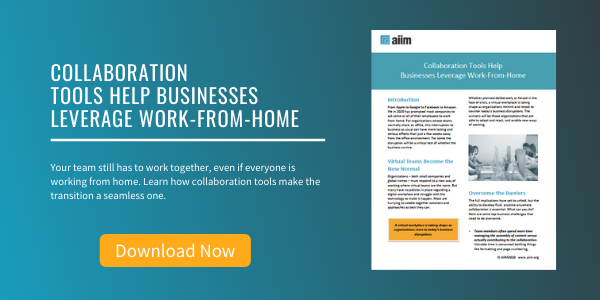
8 Ways to Benchmark Your Collaboration Strategy
It used to be that a company-wide collaboration strategy was a nice-to-have. No more. Now, it’s a strategic necessity.
Even in the current economic climate, 37 percent of organizations surveyed in Forrester's Q4 2008 enterprise and SMB software survey consider implementing a collaboration strategy important in 2009.
What’s driving the collaboration wave? Forrester sees two broad trends driving this: there is a critical need to drive information worker efficiency and to manage the unstructured content artifacts they produce and, while the value of improved collaboration is clear, the path to success has become more complex.
Collaboration strategies today need to encompass a broad array of organizational and technical criteria. The potential benefits can be substantial, and the risk associated with poor management of collaborative content and communication artifacts can be costly.
Here are eight things you need to do to benchmark your collaboration strategy:
-
Assemble stakeholders.
Collaboration has broad implications, and the stakeholders who you will need to drive the strategy must represent various organizational and geographical parts of your organization. Expect to work with a broad array of business and IT users, including users representing broad business perspectives and other representing broad geographic requirements, IT professionals representing broad business capabilities, infrastructure and operations professionals, and human resources and legal professionals.
-
Determine collaboration objectives.
A collaboration strategy needs to be anchored by business requirements. Key business objectives that require assessment are workers' ability to find relevant information and to identify expertise within the organization. Once information and expertise are identified, what mechanisms are in place to facilitate efficient interaction and knowledge reuse?
-
Conduct a workforce assessment.
Not all workers will want or require the same collaboration capabilities. Forrester recently published its Workforce Technographics data, a survey of over 2,000 information workers on what enterprise tools they are using. Some will need specialized capabilities like extensive mobile support or the ability to collaborate across organizational and firewall boundaries. Provisioning the correct level of capabilities for each segment of a heterogeneous workforce can drive down costs associated with a broad collaboration project.
-
Pay attention to organization and policy.
Collaboration software requires special attention in regard to organization and policy. The ad hoc nature of collaborative interactions opens the door for breaches in security, privacy, and regulatory compliance. While some of these can be handled programmatically through one or more technical solutions, many will require a specific policy. With proper diligence, the introduction of new collaborative technology to the environment does not increase risk. In fact, it can aid in significantly lowering risk. Further, collaborative technology is increasingly integrating with other business applications. To that end, the organization supporting a collaboration environment needs to include stakeholders to represent those systems.
-
Select a collaboration technology.
While technology is only one component of collaboration success, it remains the biggest slice of the collaboration budget and an important lever for business productivity. The landscape of available collaboration technology is rich, and choosing and integrating the right technology for an organization is a challenge. The assessment instrument provides detailed guidance on every major collaboration category: information-sharing, communications, social networking, and an integrated user experience across all tools.
-
Develop a service delivery model.
Collaboration requires enterprise-scale services to manage team sites globally, use a single network that allows global presence or search, and implement global standards for the tool kit. In best practice, this means 1) implementing a service delivery model that encompasses operating globally for consistency, access, and governance, 2) deploying servers regionally to lower latency and to allow incremental deployments, and 3) pushing administration and needed control down to local administrators to empower the needs of specific groups and regions. Our assessment tool will help you prioritize and assess gaps in these areas.
-
Develop a change management strategy.
The old saying, "If you build it they will come," has not always been true for collaboration solutions. Many organizations have struggled to drive the adoption of technologies like workspaces, instant messaging, and knowledge management systems. Information workers have a great deal of autonomy in carrying out their jobs and may be hesitant to adopt new tools if they doubt the value. A change management strategy is needed to assess the requirements of tools by workforce need and ensure proper adoption.
-
Measure the impact.
To link technology investment to business impact, a collaboration strategy will mandate metrics on adoption, use, and impact. A collaboration strategy will help you prioritize metrics in four tiers: adoption, activity, cost avoidance, and productivity improvements.
The road to success can be complicated but is definitely manageable. The greater the rigor that can be applied to the process of developing a strategy, the greater the chances of success.
About John Mancini
John Mancini is the President of Content Results, LLC and the Past President of AIIM. He is a well-known author, speaker, and advisor on information management, digital transformation and intelligent automation. John is a frequent keynote speaker and author of more than 30 eBooks on a variety of topics. He can be found on Twitter, LinkedIn and Facebook as jmancini77. Recent keynote topics include: The Stairway to Digital Transformation Navigating Disruptive Waters — 4 Things You Need to Know to Build Your Digital Transformation Strategy Getting Ahead of the Digital Transformation Curve Viewing Information Management Through a New Lens Digital Disruption: 6 Strategies to Avoid Being “Blockbustered” Specialties: Keynote speaker and writer on AI, RPA, intelligent Information Management, Intelligent Automation and Digital Transformation. Consensus-building with Boards to create strategic focus, action, and accountability. Extensive public speaking and public relations work Conversant and experienced in major technology issues and trends. Expert on inbound and content marketing, particularly in an association environment and on the Hubspot platform. John is a Phi Beta Kappa graduate of the College of William and Mary, and holds an M.A. in Public Policy from the Woodrow Wilson School at Princeton University.



